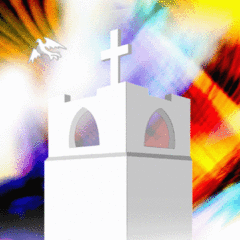As Christians we’re very acquainted with the gospel message that God loves us, and that God loves us so much that he gave to the world his Divine Son, our Lord Jesus the Messiah (Mashiach), to atone for our sinfulness and to redeem us from sin, death and the devil. But have you ever wondered why God loves us?
So, why is it that God loves us in the first place?
Thankfully, we find the beautiful and powerful answer to this question from the Word of God within the Holy Scriptures. In many passages throughout the Holy Bible, the twofold biblical reason why God loves us so much is simply because we are [1] his cherished creations and [2] his beloved children. As God’s cherished creations, we are his artwork, his building, his craftsmanship. We are God’s painting, God’s musical composition, God’s architectural design, God’s masterwork. And, of course, as we are Almighty God’s offspring (children of our Heavenly Father), we are loved with a fully parental, self-giving and self-sacrificing kind of love.
(Psalm 139:13-14a) – “For it was you who formed my inward parts; you knit me together in my mother’s womb. I praise you, for I am fearfully and wonderfully made. Wonderful are your works…”
(Isaiah 64:8) – “Yet, O Lord, you are our Father; we are the clay, and you are our potter; we are all the work of your hand.”
(Matthew 6:9) – “This, then, is how you should pray: ‘Our Father in heaven, hallowed be your name’…”
We are indeed cherished creations and beloved children of God, first and foremost. Humankind is created in the image of God (imago Dei) as a complementary balance of female and male (yin/yang), and, although women and men are very different, we are equal in our God-given value and dignity. In addition, humanity is a beautiful kaleidoscope of ethnicities and cultures, but we are one human race that is endowed with inalienable human rights and responsibilities.
(Genesis 1:27) – “So God created humankind in his image, in the image of God he created them; male and female he created them.”
(Acts 17:26-29) – “From one ancestor he made all nations to inhabit the whole earth, and he allotted the times of their existence and the boundaries of the places where they would live, so that they would search for God, and perhaps grope for him and find him — though indeed he is not far from each one of us. For ‘In him we live and move and have our being’; as even some of your own poets have said, ‘For we too are his offspring.’ Since we are God’s offspring, we ought not to think that the deity is like gold, or silver, or stone, an image formed by the art and imagination of mortals…”
Consequently, our core identity is not centered on any sociological ideology or theory of conflict that’s obsessed with group identities, differences and partialities. Rather, as beloved children of God, our core identity is purely based upon the universal truth of the Word of God and upon the all-encompassing love and grace of God revealed in Jesus the Christ (Christos).
(John 17:17) – “Sanctify them by the truth. Your word is truth.”
(Ephesians 5:1-2) – “Therefore be imitators of God, as beloved children, and live in love, as Christ loved us and gave himself up for us, a fragrant offering and sacrifice to God.”
Knowing why God loves us, we can live our daily lives in this wonderful awareness “as beloved children.” Although our human condition is fallen and sinful, our human nature is divine as offspring of Almighty God. So, we must always uplift and rejoice in our true identity and heavenly heritage as human beings.
Therefore, we praise the God and Father of our Lord Jesus Christ, through whom God created us and the countless worlds of our universe (see John 1:1-4 and Colossians 1:15-17 and Hebrews 1:1-2). With deep gratitude and thanksgiving, we can live every single day in the awareness that we are cherished creations and beloved children of our Heavenly Father, and that God loves us so much that he gave us his Holy Son, Jesus (Yeshua), to be the once-and-for-all sacrificial offering of atonement for the sins of humanity (see John 3:16-17 and Hebrews 10:10-14 and First John 4:9-11). Glory to God in the highest!!!
Happy Thanksgiving & Good Advent! Pastor Tim
